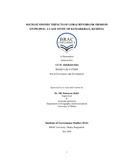Socio-economic impacts of Gorai riverbank erosion on people: a case study of Kumarkhali, Kushtia

View/
Date
2014-07Publisher
BRAC UniversityAuthor
Baki, A.T.M. AbdullahelMetadata
Show full item recordAbstract
The purpose of this research was to identify socio-economic impacts of riverbank
erosion on people of Kumarkhali. It was hypothesized that the socio-economic impacts
of riverbank erosion on affected people are quite significant and enormous. The findings
of the study reveal that affected people have experienced substantial socio-economic
impoverishment. At Kumarkhali point the erosion of Gorai solely started in the 40s of
the last century. But at that time the erosion was not so remarkable for the inhabitants. A
large number of people think that it took severe form specially when the river Kaliganga
and the Dakatia were blocked at the time of implementing GK Project in the 50s. Some
others believe that heavy siltation due to the lack of natural flow of Gorai as because of
the Farakka barrage is another important reason of continued erosion. Whatever might be
the reason all most 100% of the people on the bank line of Gorai had/have suffered due
to erosion. Loss of homesteads, cultivable lands, kitchen garden lands & home yard
lands have played vital role for the change of their livelihood pattern. Due to this they
have lost their familial and social ties, have got separated from their kith and kin, and
most painfully income erosion have turned them from well-off to poor overnight.
Irony is that several measures have been taken to control erosion from late 1960s to mid
1990s of the last century. But erosion continued as those measures were not taken at the
right time. Even no consultation has been made with the victims when groin or revetment
was made. 100% victims have said that, they are not consulted at the time of making
groin or revetment. In a third world country like Bangladesh policy planning and
implementation is almost a top-down approach. Moreover the policy is very often
political motive and personal interest driven. It does not fulfill the need of the people.
Hence governance is a very important issue for the effective planning and execution of
the policy. Bad governance works as a catalyst for increased vulnerability of the people.
Riverbank erosion at Kumarkhali is a classic example of this and that’s why the people
of the locality are suffering generation after generation.
Policy makers will have to learn from this experience and top down approach at the time
of policy planning should be avoided.
Lack of good governance always increases the vulnerability of the people. So without
good governance no development is real development. At the time of planning and
implementation the policymakers should keep it in mind otherwise development will not
be purposeful, sustainable and effective.
